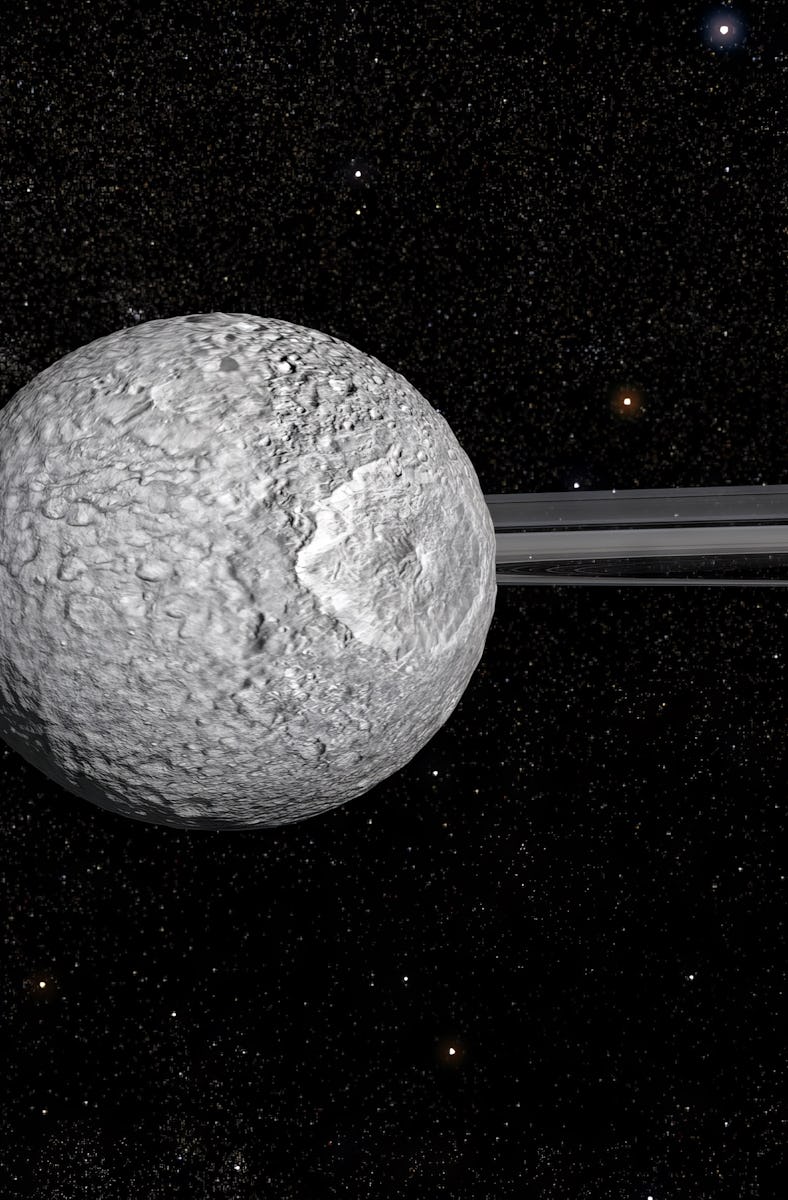Saturn's "Death Star" Moon Mimas May Actually Be Packed Full of Water
Still no sign of that exhaust port, though.

Saturn’s moon Mimas may have an ocean of liquid water beneath its icy crust, suggests a recent study.
Icy moons with oceans locked away beneath miles of ice are turning out to be fairly common in our Solar System. If tiny Mimas has one, scientists surmise there might be far more than we think. There could even be one in orbit around Uranus.
Observatory of Paris astronomer Valery Lainey and his colleagues published their work in the journal Nature.
Mimas is only about 246 miles wide.
Of Course, the Death Star Moon has a Stealth Ocean
Lainey and his colleagues studied old data from NASA’s Cassini mission (RIP), which had carefully tracked subtle changes in Mimas’s orbit around Saturn. Every time the moon makes a lap around Saturn, its periapsis (the point at which it is closest to the planet) shifts slightly; if you mapped those changes, they’d trace a circle around Saturn, moving in the opposite direction from the moon’s orbit. Astronomers call this “orbital precession,” and it depends on the shape of Mimas’s gravitational field— which, in turn, depends on the moon’s shape and what it’s made of inside.
When Lainey and his colleagues ran computer models, the only simulated moon that precessed like the real Mimas was one with a deep ocean layer of liquid water inside, hidden away beneath 12 to 18 miles of ice.
That’s surprising because, from the outside, Mimas looks like a solid ball of ice with a big dent on one side: a crater called Herschel, which is the centerpiece of the moon’s whole Death Star cosplay. There’s no sign that huge masses of water are sloshing around beneath the frozen surface. Enceladus, Saturn’s other icy ocean moon — and Jupiter’s version, Europa — both have huge fissures and jumbled, chaotic terrain where the churning water beneath has cracked the ice and slammed huge floating ice slabs together.
Although Mimas is sporting that enormous crater from an ancient impact, its surface isn’t cracked or chaotic. Despite some speculation about an ocean beneath the ice, planetary scientists mostly concluded that it’s frozen all the way to its rocky core.
Speaking of craters, Herschel crater has always been another piece of evidence that Mimas wasn’t hiding an ocean beneath that icy exterior. Physicists have a pretty good understanding of how various materials deform (squash, stretch, or break) when giant space rocks slam into them, and their simulations found that the huge crater couldn’t have formed if the moon’s surface were just a thin (well, less than 20 miles) shell of ice over liquid water. Instead, the ice would probably have just broken. The crater’s very existence points to a frozen-solid moon.
But despite all of that, Mimas moves around Saturn as though it’s got a layer of water inside. Lainey and his colleagues say all of the evidence — the uncracked surface, the giant crater, and the precessing orbit — makes sense only if Mimas’s hidden ocean is fairly young: younger than the Herschel crater and much, much younger than the waters beneath the ice of Europa and Enceladus. “Young” is a relative term, of course; Lainey and his colleagues estimate that the ocean on Mimas has been around for less than 25 million years, and it’s only managed to thin the ice above it to its current depth within the last 2 or 3 million years.
That explains the moon’s surface and its orbital motion, but what explains the ocean itself?
How Tides Will Freeze an Entire Ocean
Mimas’s orbit around Saturn is a huge ellipse, closer to Saturn at one end than the other. That’s probably thanks to a close encounter with another moon sometime in Saturn’s past, which pulled Mimas’s orbit off-kilter.
“The changing distance causes a difference in the gravitational pull of the planet on the moon throughout each orbit, which can change its shape,” Southwest Research Institute planetary scientist Alyssa Rose Rhoden (co-author of a paper commenting on the recent study) tells Inverse. “This mechanism is referred to as tides.” Tidal motion generates heat deep inside the moon, which melts ice into sloshing liquid water.
Over time, that sloshing water will pull Mimas into a rounder orbit, one with less extreme tides and, thus, less heat. Slowly, the hidden ocean will probably freeze solid again unless another close encounter intervenes.
“At least the icy crust thickness will get thicker in the near future,” Lainey tells Inverse. “Nevertheless, it is possible that future excitation of Mimas eccentricity will appear again from gravitational perturbations with other moons or the Saturnian rings. We have not yet considered the future of Mimas orbital evolution.”
Enceladus and Europa’s oceans are much longer-lived because they’re in what astronomers call “orbital resonances” with other moons.
“For example, every time Europa goes around Jupiter one time, Io has gone around two times, and the moons align. In addition, for every two orbits of Europa, Ganymede goes around Jupiter once, and they align,” says Rhoden. “Similarly, Enceladus is in a resonance with Dione.”
Thanks to those regular alignments, the moons’ paths around their planets keep getting tugged and stretched back into oval shapes, which keeps the tidal heating going. That could be very good news for possible life — or at least habitability — beneath the ice of Europa and Enceladus, but Mimas’s ocean probably won’t last long enough for that. On the other hand, Mimas can help us understand more about how these kinds of icy oceans form and how common they are in the Solar System.
And if, as Mimas seems to suggest, watery oceans are more common on smallish icy moons than scientists expected, that could spark new interest in the moons of Uranus, which may be getting its own mission in the coming decade.
This article was originally published on